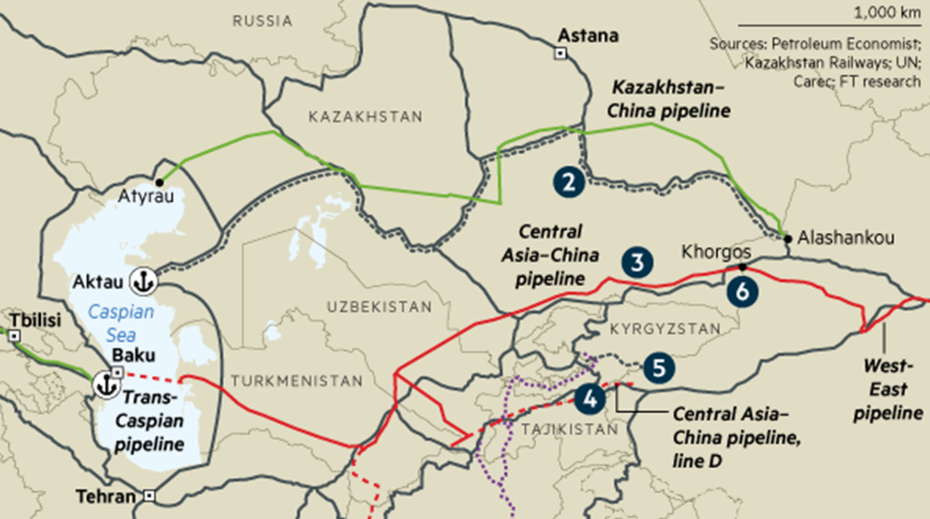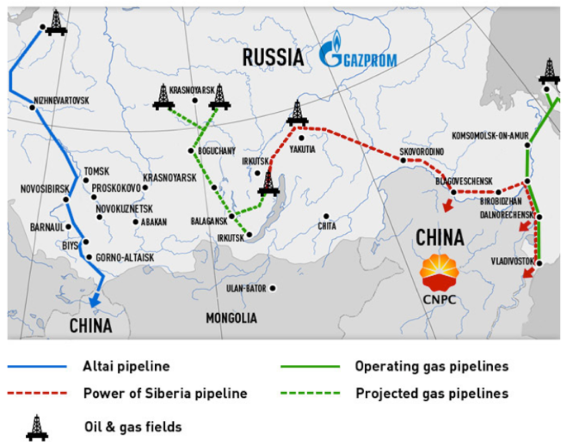Diplomatic relations between Moscow and Beijing have significantly improved over the past couple of decades. During the Cold War, the Soviet Union and China were on the brink of war which the U.S. exploited with the ‘Opening of China' during the Nixon administration. However, recent geopolitical and economic developments have created a new strategic environment: Russia controls some of the world’s largest reserves in terms of resources such as oil and gas while China’s expanding economy requires ever-larger volumes of raw materials.
The crisis between Russia and the West has created a rift between Moscow and Europe, its most important customer regarding natural gas. To maintain a steady flow of demand for Russian gas, a political decision was made to speed up negotiations between the state-sponsored companies Gazprom and China National Petroleum Corporation for new energy infrastructure. A historic deal was struck in 2014 concerning the Power of Siberia pipeline valued $400 billion for 38 bcm of gas over 30 years. While the first delivery of gas is set on December 1st, negotiations are ongoing for another pipeline which would make China Gazprom's most significant customer within a decade.
A critical moment in time
The Power of Siberia-2 or Altay pipeline is not a new idea. The infrastructure has been discussed on both sides of the border but with no actual plan for construction. New developments, however, have significantly increased the need for additional capacity. The most important circumstance is the fast-growing demand for natural gas in China for which domestic production is not sufficient.
Due to environmental reasons, Beijing has decided to implement the coal-to-gas policy which has increased demand by 23 percent from 195 bcm in 2015 to 240 bcm in 2017. The import of relatively expensive LNG increased by 44 percent in 2018 compared to 2017 to approximately 55 Mton or 75 bcm. Currently, China only imports pipeline gas from Central Asia which has reached 51 bcm in 2018.
Related: The Ultimate Tool To Prop Up Oil Prices
Due to the expectation that demand will keep on growing, Beijing has been looking for an alternative to LNG imports. Last year, during the economic forum in Vladivostok, Presidents Putin and Xi committed their state gas companies to reopen negotiations on a new pipeline option from Russia to China, the Power of Siberia-2 pipeline. Diversification in China’s most remote western regions would improve energy security by decreasing dependence on Central Asia.

(Click to enlarge)
The existing infrastructure in the region, the so-called Central Asia-China pipeline, consists of the lines A, B, and C with a maximum capacity of 55 bcm. A project to extend the pipeline with line D is shelved due to specific concerns on the Chinese side. Beijing is worried about overdependence on the region. CNPC’s statement accused “frequent equipment failures” in Turkmenistan of causing shortages in China. Also, Kazakhstan is suspected of diversions of gas and the resulting pressure drops in China during the winter of 2012-13.
Gazprom’s long-time dream
It is painfully evident for Moscow that Europe has become a difficult market for Russian gas. The issue of energy security is high on the European political agenda. The construction of Nord Stream 2 is facing significant pushback from European politicians in several countries as well as Washington which has threatened with sanctions to derail the project. Recently, EU energy ministers have made an agreement that could delay the completion of Nord Stream 2, but probably not stop it. Also, in the case of Turk Stream Gazprom faced significant opposition. Despite a high probability that both projects will be completed, the limits of Russian gas in Europe is within sight.
Therefore, diversification is also high on the Russian agenda. Currently, Germany is the biggest buyer of Russian gas. That could change when the second interconnector with China is built. Energy security for Russia entails a steady flow of revenue for the state coffers. Furthermore, Gazprom has also been pushing for the western route which is much cheaper to construct because of pre-existing infrastructure in Western Siberia.

ADVERTISEMENT
(Click to enlarge)
Despite the ever-closer political relations between Moscow and Beijing, the Chinese are notorious for being formidable partners when it comes to negotiations. Although the current political climate is benefiting negotiations, several wild cards remain. China’s ongoing trade talks with the U.S. could alter the situation. Beijing could compromise on the trade imbalance through an agreement to buy additional American LNG. That could be bad news for alternative suppliers. However, it remains the question whether Beijing is willing to commit itself into a position of vulnerability vis-à-vis its strategic competitor.
By Vanand Meliksetian for Oilprice.com
More Top Reads From Oilprice.com:
- How Sanctions Are Helping The U.S. Become A Net Oil Exporter
- Permian Production To Break 4 Million Bpd In March
- A Worrying Trend For International Oil Giants



















The cooperation in the energy field between the world largest importer of both oil and gas and the world’s largest producer of oil and also largest exporter of natural gas is like a marriage made in heaven.
Russia is now China’s largest supplier of oil providing more than 1.55 million barrels a day (mbd) and is also emerging as China’s largest supplier of gas. With the Power of Siberia 1 gas pipeline becoming operational by the 1st of December this year, Russia will start an annual delivery of 38 billion cubic metres a year (bcm/y) to China for the next thirty years. The pipeline capacity can be increased to 61bcm/y if Putin decides to cut the shipment of natural gas to Europe in favour of China.
However, the fast-growing demand for natural gas in China for which domestic production is not sufficient and China’s decision for environmental reasons to implement the coal-to-gas policy have created the need for more gas pipeline capacity to bring more Russian gas supplies to China, hence the Power of Siberia 2.
Last year, during the economic forum in Vladivostok, President Putin and the Chinese President Xi agreed to reopen negotiations on a new pipeline option from Russia to China, the Power of Siberia-2 pipeline. Diversification in China’s most remote western regions would improve energy security by decreasing dependence on Central Asia.
And with the eventual completion of Nord Stream 2 and the Turk Stream gas pipelines, Russia’s dominance in the EU fast-growing gas market will be unassailable. Still for Russia, a diversification of its gas export destinations is not only high on its agenda but it is also prudent.
The completion of the Power of Siberia 1 gas pipeline will send a huge signal to the EU that Russia is not vulnerable to economic or geopolitical pressure on gas prices or supplies as it could easily switch its gas supplies from the EU to China.
Economically, under China’s Belt and Road (BRI) Initiative, Russia has become one of the biggest recipients of Chinese investment receiving $46 bn in Chinese funding for BRI projects, the latest of which was the Yamal LNG project in Russia’s Yamal Peninsula. The project aims to tap natural gas reserves totalling more than 164 trillion cubic feet.
Bilateral trade between the two countries is projected to reach $100 by 2020. There is also their close cooperation in supporting the petro-yuan to become the leading currency for the global oil trade.
Geopolitically, both Russia and China rank their strategic partnership as the “peak” in mutual history. This can be judged by two analytical frameworks: their converging visions of the future world order and their harmonized national interests.
The Chinese view on the world order at this historical juncture is shared and dovetailed by Putin’s Russia. From Beijing’s point of view, it is the brewing trade war against China and the United States’ inability to reconcile itself with the fact that China’s economy is now the world’s largest and that the petro-yuan is starting to undermine the petrodollar which is the core of the US financial system.
From Moscow’s perspective, the Western alliance took advantage of post-Soviet chaos to push the Western sphere of influence towards the Russian border.
In sharp contrast to mutual suspicion and deteriorating relationship between the US on the one hand and Russia and China on the other, the Chinese-Russian tie has proved to be a stable strategic partnership built on mutual understanding, respect and national interests. It is also a healthy check on Washington’s “unipolar folly”.
Dr Mamdouh G Salameh
International Oil Economist
Visiting Professor of Energy Economics at ESCP Europe Business School, London
What should be addressed is whether Nord Stream-3 is not far in the future.